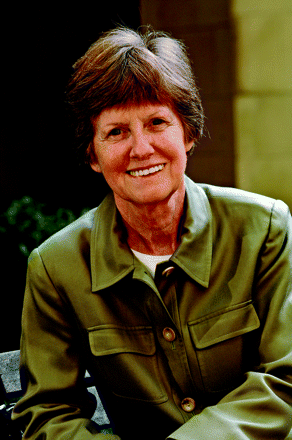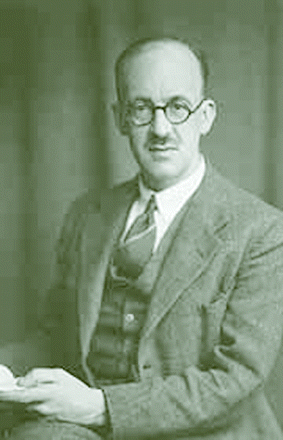Centennial Perspective: Serotonin Receptors
When the senior author agreed to write a historical overview of serotonin (5-HT) receptors, she did so without much thought of the magnitude of such an undertaking. Having been introduced to 5-HT research in 1962 as a graduate student, a mere five years after Gaddum and Picarelli proposed the first classification of 5-HT receptors, Sanders-Bush was there at the beginning. But with fourteen 5-HT receptors now recognized, the task of a historical account seemed overwhelming, hence the solution was to choose four seminal papers that were considered landmarks, shaping the field.
This paper, with the initial classification of 5-HT receptors is, without a doubt, the first paper that veterans of the 5-HT receptor field think of as a landmark.
The contributions of Sir John Henry Gaddum, a leading British physiologist and pharmacologist, span many areas of chemical neurotransmission, including the role of 5-HT in the periphery and in the brain. A collaborator of Dale, von Euler, and Schild, Gaddum was known for rigorous experimental design that combined mathematical and technical genius. In the mid 1950s, Gaddum and an associate performed a series of classical organ-bath experiments on the pharmacological properties of 5-HT in guinea pig ileum (1). This paper is hard to find online, but was reprinted in 1997 (2). Based on earlier experiments showing that antagonists had different effects on 5-HT in various tissues, Gaddum postulated that there were two kinds of 5-HT receptors, one that was sensitive to LSD and other ergot derivatives, and another that was not. Because LSD only blocked 50% of the 5-HT elicited contraction in guinea pig ileum, Gaddum hypothesized that the two types of 5-HT receptors co-existed in this tissue. In a series of simple, but elegant experiments, dibenzyline and morphine were shown to act as specific antagonists for two distinct “tryptamine receptors,” which were named D receptors (sensitive to dibenzyline and also LSD) and M receptors (sensitive to morphine as well as atropine). Based on these and earlier experiments, D receptors were thought to be on smooth muscle, while M receptors were thought to be in nervous tissue. This pioneering work set the stage for subsequent physiological experiments first in peripheral tissues and ultimately in brain that were guided by this early evidence of more than one 5-HT receptor.
This paper reshaped the field, ushering in a virtual flood of radioligand binding studies—today this methodology is still a mainstay of our tool chest—and defining a new nomenclature.
Over the years, although the M and D nomenclature and principles were acknowledged, it became evident, based on classical pharmacological experiments, that the myriad of physiological and behavioral effects elicited by 5-HT must reflect multiple receptors. In the late 1970s, papers from several different laboratories, including leaders in the field, such as George Aghajanian (Yale) (3), Josee Leysen (Janssen Pharmaceuticals, Belgium) (4), Michel Hamon (INSERM, Paris) (5), and Fillion et al. (6) considered the question of multiple 5-HT binding sites or multiple affinity states for 5-HT. It was, however, the 1979 Molecular Pharmacology paper of Steve Peroutka and Sol Snyder that galvanized the field (7). This paper directly compared the binding of three radioligands, 3H-5-HT, 3H-spiroperidol and 3H-LSD, presenting clear evidence that 3H-5-HT and 3H-spiroperidol bound to separate and distinct sites while 3H-LSD bound to both sites. With clever use of masking drugs, it was possible to differentiate the two sites in 3H-LSD binding that agreed pharmacologically with the individual sites labeled by the other two radioligands. Thus, as was found earlier for catecholamine receptors, there were distinct subtypes of 5-HT receptors that could be differentiated by radioligand binding. In an accompanying paper in Molecular Pharmacology, Peroutka and Snyder (8) reported that both the 3H-5-HT-labeled and the 3H-spiroperidol-labeled 5-HT binding sites were differentially regulated by guanine nucleotides; only the 3H-5-HT labeled site was reduced, again clear evidence for two distinct 5-HT receptor subtypes.
Publication of this work led to a surge of research that took advantage of these paradigm-shifting experiments, utilizing radioligands to characterize and quantify distinct populations of 5-HT-related sites. Many subsequent leaders in the field utilized this strategy and premise over the next several years as the field blossomed. Furthermore, the original suggestion by Peroutka and Snyder that the binding site labeled by 3H-5-HT be designated 5-HT1 and the binding site labeled by 3H-spiroperidol be referred to as 5-HT2 (7) was accepted by the field and this terminology became commonplace.
The next major goal of the 5-HT receptor field was to relate the binding sites to the multiple physiological actions of 5-HT. A breakthrough came when the signaling pathways for 5-HT receptors were identified, the first being the adenylate cyclase/cAMP pathway. Although reported in an earlier paper that administration of 5-HT increased cAMP concentrations (9), it was a Molecular Pharmacology paper from Joel Bockaert’s group (10) that caught attention, and in combination with the Peroutka and Snyder (8) paper initiated the race to define the second messenger pathways for the two 5-HT receptors. In 1983, the Costa group (11) suggested that the ability of 5-HT to stimulate adenylate cyclase in rat hippocampus was mediated by the 5-HT1 receptor. Soon there-after, the Costa laboratory (12) and the Sanders-Bush laboratory (13) presented evidence that 5-HT in aorta and in brain, respectively, activated a second major signal transduction pathway, involving phospholipase C, leading to the hydrolysis of membrane phosphoinositides and calcium mobilization. Pharmacological studies were consistent with the interpretation that this signaling pathway was mediated by the 5-HT2 receptor, and thus, in the span of one year, the two known 5-HT binding sites had been proposed to couple to the two known transmembrane signal transduction pathways. Earlier, Michael Berridge (14) had shown that 5-HT elicited both cAMP formation and calcium release by distinct receptors in the salivary gland of the blowfly, but the pharmacological properties were difficult to relate to mammalian receptors and, indeed, led to an incorrect classification. Those familiar with the current nomenclature may be confused because it is now accepted that 5-HT1 receptors are negatively coupled to adenylate cyclase (i.e., decrease cAMP). Newer 5-HT receptors, such as 5-HT4 and 5-HT7, activate adenylate cyclase, and the latter may in fact have been the receptor classified in early adenylate cyclase studies. Indeed, the early studies of 5-HT activation of adenylate cyclase were confusing and inconsistent, with evidence that the pharmacology was not consistent with the 5-HT1 site and that perhaps more than one adenylate cyclase-regulating subtype existed. This was found to be true and now there are five recognized subtypes of the 5-HT1 receptor family.
. This was the first report of a full-length cloned 5-HT receptor gene whose protein product was functional. Interestingly, the 5-HT1c receptor was later renamed 5-HT2C receptor by an international receptor nomenclature committee. The cloning and subsequent ability to create heterologous cell lines expressing a receptor cDNA greatly facilitated drug discovery efforts and numerous basic studies of structure and function.
The proliferation of reports of novel pharmacological profiles in physiological and biochemical experiments was at times almost breathtaking. There appeared to be a bewildering number of 5-HT receptor subtypes, which led to the speculation that apparently unique properties might be related to assay conditions or to less than ideal tools (drugs) for defining the receptors. The era of molecular biology and receptor cloning dispelled this speculation as more 5-HT receptor subtypes were cloned and definitively identified as unique molecular entities.
The first serotonin receptor clone, the 5-HT1c receptor (now termed 5-HT2C, see below), was reported in 1988 by David Julius while a fellow in Richard Axel’s laboratory at Columbia University (15). The cloned 5-HT1c receptor had many sequence and structural similarities with previously cloned G protein coupled receptors, including seven hydrophobic stretches thought to represent seven transmembrane segments. Fibroblasts transfected with the presumed 5-HT1c receptor cDNA became responsive to 5-HT, eliciting a marked increase in intracellular calcium, the intracellular signal associated with the 5-HT1c receptor. These cells also exhibited high affinity 125I-LSD binding with pharmacological properties consistent with the 5-HT1c receptor. Although the Julius paper in 1988 was the first report of a full-length, functional 5-HT1c receptor, it was surrounded by considerable activity from several groups that cloned partial-length receptors or an unidentified 5-HT receptor. One year earlier, Lubbert et al. (16) utilized a clever RNA fractionation strategy followed by expression in Xenopus oocytes to isolate a partial-length 5-HT1c receptor cDNA that was fully functional. A similar strategy was utilized by Julius et al. (15) to isolate the full-length clone. This strategy was likely successful because both groups started with RNA isolated from the choroid plexus, which expresses picomole quantities of the 5-HT1c receptor.
A fascinating bit of detective work led to the first report of the cloning of the 5-HT1A receptor by the Lefkowitz/Caron group at Duke University (17), which was published just two months after the Julius paper. Cloning of the 5-HT1A receptor, initially designated G-21, was accomplished by Kobilka et al. (18) by cross-hybridization at reduced stringency with the β2-adrenergic receptor; however, its identity was unknown. It was a full year later before the G-21 clone was convincingly shown to be the 5-HT1A receptor (17). The race to clone all 5-HT receptors seems to be near completion, although there are still some orphans trying to break into the ranks.
With the numerous reports of the cloning of yet another 5-HT receptor, the challenge was to integrate the genomic information with the substantial data available on the pharmacology and function of 5-HT receptor subtypes. An exceptionally thorough and insightful analysis of this problem appeared in the nearly fifty-page article by Hoyer et al. (19) published in Pharmacological Reviews.
With the proliferation of 5-HT receptor subtypes, it became obvious that a standard nomenclature was needed. The Serotonin Club started the process (20), and the official new classification scheme was published in 1994 by an IUPHAR receptor classification committee, composed of international leaders in the field with a combined total experience of 100 years!
5-HT has the greatest number of receptors (the current number is fourteen) of any neurotransmitter. At the time of the IUPHAR classification, all recognized 5-HT receptors were cloned, except the 5-HT4 receptor, where the in vivo evidence was so compelling to convincingly argue that a distinct receptor exists. Thirteen of the recognized 5-HT receptors are G protein coupled; the 5-HT3 receptor is the sole ligand-gated ion channel. The rigorous criteria used to classify a receptor subtype meant that some of the cloned receptors (e.g, 5-HT5, 5-HT6 and 5-HT7) were not given full endorsement because detailed pharmacological studies and/or signal transduction mechanisms were not yet available.
There were some surprises in the classification scheme; the most dramatic being in the 5-HT2 family of receptors. The 5-HT1c receptor was renamed 5-HT2C because of its structural similarity to the 5-HT2 receptor, their identical second messenger pathways, and similar pharmacological properties. The 5-HT2F receptor, which had been characterized in stomach fundus (21), was renamed 5-HT2B and the classical 5-HT2 receptor, as described by Peroutka and Snyder (7) was renamed 5-HT2A. To avoid confusion, the 5-HT1c term was “retired,” but there were still five 5-HT1 subtypes: 5-HT1A, 1B, 1D, 1E, and 1F. The new classification scheme was extremely well-received and accepted by the field. Amazingly, for example, the term 5-HT1c receptor essentially disappeared from PubMed within a year after publication of the Hoyer et al. review article (19), illustrating its major impact on the field.
What will be the next seminal discovery in the 5-HT receptor field?
Near the end of preparing this article, we looked at citation statistics in the Web of Science database and found that the four highlighted papers have a total of 4965 citations to their credit, confirming our judgment that these were ground-breaking papers that reshaped the field. We note that our overview of seminal papers ends in 1994 and important research has transpired in the intervening years. There are many excellent reviews and a new version of the Serotonin Receptors book, published in 2006 [edited by Bryan Roth (22)], providing extensive resources for filling in the missing years.
What do we have to look forward to in the future? With respect to pharmacology and therapeutics, the most successful 5-HT-related clinically useful drugs secondarily influence receptors by manipulating levels of the neurotransmitter (e.g., selective 5-HT reuptake inhibitors). In the future, we should see the exploitation of pharmacology to develop centrally acting drugs that interact directly with 5-HT receptors, either as full or partial agonists, full or partial inverse agonists, competitive antagonists, or allosteric ligands that modulate the actions of agonists. The recent publication of the crystal structure of the human β2-adrenergic receptor (23) will facilitate drug discovery; however, the challenges inherent in crystallizing less abundant G protein coupled receptors are magnified for the 5-HT receptors because of limited availability of key reagents for protein purification, such as specific antibodies and ligand affinity chromatography. Even with improved understanding of structure and function, identifying drug candidates that target a specific 5-HT receptor is hampered by our cursory understanding of the precise role of 5-HT receptors in human disease. Genetically engineered mice, in which a specific receptor has been overexpressed or deleted, have shed light on the role of 5-HT receptors in disease symptoms. The combination of molecular genetic manipulations in mice and insights into naturally occurring mutations in humans (e.g., single nucleotide polymorphisms) will hopefully validate, or at least strengthen, the choice of a particular receptor as a therapeutic drug target.
- © American Society for Pharmacology and Experimental Theraputics 2008
References

David C. Airey, PhD, received his doctoral degree from Cornell University in Biological Psychology and is currently a Research Assistant Professor in the Department of Pharmacology, at Vanderbilt University School of Medicine. His research interests include the study of the genetic and post-transcriptional sources of individual variation in central nervous system; mouse pre-clinical discovery models of serotonergic function and psychiatric disease; and RNA editing of 5-HT2C receptors. fax 615-936-3747.

Elaine Sanders-Bush, PhD, is a Professor in the Departments of Pharmacology and Psychiatry at Vanderbilt University School of Medicine.Her long standing research on serotonin receptors has made major contributions ranging from pharmacology and signal transduction to in vivo brain function. Address all correspondence to ESB. E-mail elaine.bush{at}vanderbilt.edu; fax 615-936-3745.








